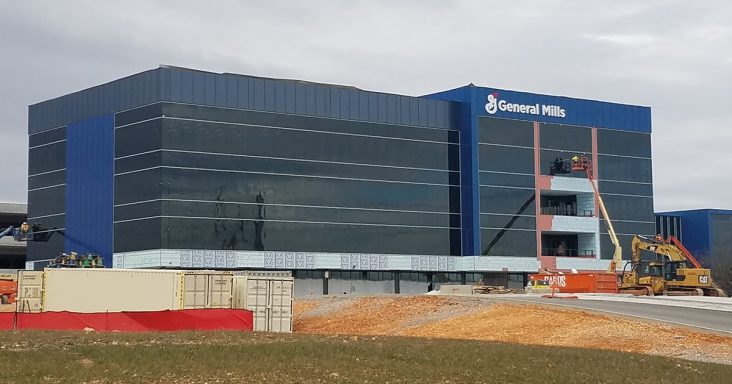‘Flight to quality’ continues in Northwest Arkansas office market
by February 22, 2021 11:17 am 5,362 views

Construction continues on the 117,000-square-foot Founders Plaza office building in Rogers.
A new report from commercial real estate firm CBRE Group Inc. says many aspects of Northwest Arkansas’ office leasing have slowed, especially for second-generation buildings.
However, the new construction office space remains free of significant vacancy issues.
“This ‘flight to quality’ regarding office space has been a common theme for the past few years, meaning first-generation office space usually is met with absorption more quickly than that of second-generation space,” David Erstine wrote in the report. Erstine is first vice president for CBRE in the company’s Fayetteville office. He co-authored the report with associate Hunter Groce.
“In Washington County, this can be attributed to occupiers requiring larger footprints or more efficient footprints. In Benton County, we attribute this to occupiers desiring newly constructed buildings with increased available amenities such as outdoor space, fitness facilities, shared conference rooms and food/beverage offerings within the building or walking distance.”
In an overview of Northwest Arkansas’ Class A office market in 2020, CBRE reports a 12.26% vacancy rate among 46 buildings in Bentonville, Fayetteville and Rogers. The buildings total 2.79 million square feet, with about 343,000 square feet available.
Erstine said Springdale is not included in the report because “historically there has been little to no sizable [Class A] office demand or supply for the Springdale market.” He said that could change over the next decade, specifically in the Don Tyson Parkway interchange area, as companies look for central locations in Northwest Arkansas.
“We are seeing increased interest from office occupiers, especially in the medical sector, around the Don Tyson Parkway interchange,” Erstine said. “As delivered square footage increases, we’ll begin highlighting the Springdale submarket.”
Other market highlights include:
- First-generation Class A rental rates continue to increase due to rising construction costs, while a decline in rent rates for second-generation Class B is more common.
- While impacted, Northwest Arkansas office markets have proven to be less susceptible to COVID-19-related decreases than urban markets throughout the country.
- Increasing construction costs continue to be prevalent.
BENTONVILLE
Bentonville’s vacancy rate remained steady last year, with a slight increase from 17.11% at the end of 2019 to 17.78% at the end of 2020. The city has 13 Class A buildings totaling nearly 836,000 square feet.
“With the limited demand we are currently seeing in the Bentonville submarket, we do not foresee this rate decreasing significantly anytime soon,” the report says. “With implications of COVID-19 increasing subleasing efforts, we predict the vacancy rate to increase in the next one to two years as leases come to expire.”

Both developments are along Interstate 49. Rice, two buildings with approximately 120,600 square feet, has about 40,000 square feet for lease, according to the CBRE report. Erstine said CBRE includes the two Barrington Centre buildings, totaling nearly 140,000 square feet, despite their Rogers address in the Bentonville market.
“They compete more for [companies] seeking space in the Bentonville area than Pinnacle [in Rogers],” he said.
Redbird office building, which is about 90,000 square feet, was completed in 2020 and is fully leased to Walmart Inc. Construction work has started two blocks south of the downtown square on a 230,000-square-foot office/retail building, known as Ledger.
FAYETTEVILLE
Fayetteville’s vacancy rate saw negative net absorption in 2020, with an increase from 3.23% at the end of 2019 to 7.21% at the end of 2020. The city has 12 Class A buildings totaling about 583,000 square feet.
Erstine said factors causing the increase are tenants relocating north along the Interstate 49 corridor and new construction.
A 35,000-square-foot building on North Vantage Drive in the new Vantage Drive Office Park is the first new Class A building in the city in more than a decade. The building is about 90% leased. A nearby building on Bellafont Boulevard (16,200 square feet) has zero space for lease. Erstine said those successes are leading additional developers to plan projects in Fayetteville.
Erstine said companies continue to pursue owner-occupied new construction, build-to-suits, conversions and remodels of non-office buildings into office buildings.
“The demand for first-generation office space is high, and even with a 7.21% vacancy rate, Fayetteville currently has a scarce inventory of Class A office space,” the report says. “Because of that, rents remain stable for new office buildings, second-generation space and even Class B office space in Fayetteville. However, market conditions could soften in 2021 due to some occupiers seeking new construction, space opportunities north of Fayetteville and uncertainties related to COVID-19.”
ROGERS
Rogers’ vacancy rate jumped from 7.55% at the end of 2019 to 11.06% at the end of 2020. The city has 21 Class A buildings totaling 1.37 million square feet.
Erstine attributes the increase to two new buildings in the Pinnacle Hills area west of Interstate 49 — Northgate Plaza Phase I and One Uptown.
Developers expect to open several office buildings in 2021, including Founders Plaza (117,000 square feet), Northgate Plaza Phase II (52,000 square feet) and The District Office Building III (40,000 square feet).
“Year in and year out, there continue to be new building announcements [in Rogers] with steel structures going up at least once a year,” the report says. “With these buildings on track for a 2021 delivery, vacancy rates will likely continue to rise in the near-term as many of these deliveries will [attract] companies] vacating older Class A product.”
Erstine said he expects companies will continue to flock to newer buildings, despite higher rental rates demanded by building owners to justify building costs.
